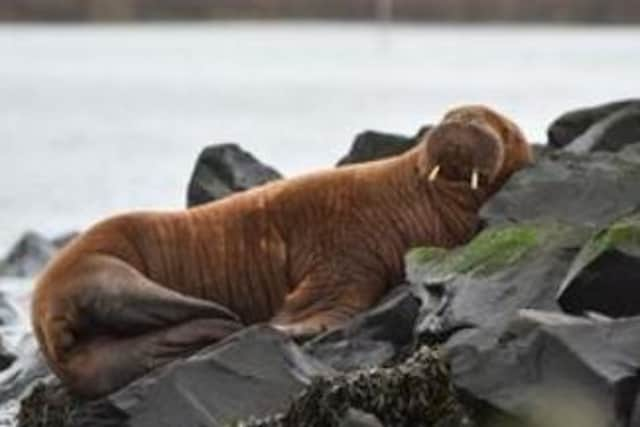Walrus makes rare visit to Northumberland coast


The juvenile female was spotted in Seahouses harbour around 9am on Sunday.
Experts believe it could be Freya, a walrus which recently spent a few days relaxing on a Dutch submarine.
Advertisement
Hide AdAdvertisement
Hide AdAndy Sisson from British Divers Marine Life Rescue (BDMLR), said: “It’s a juvenile female and may well be Freya. She’s bigger than a bull seal, perhaps three-quarters of a tonne.
“There’s been a lot of interest in her today. She has been attracting a steady stream of spectators all day but people have also been very compliant in keeping their distance.
"She is tucked up on the ballast rocks in Seahouses harbour, mostly resting, and appears to be stable.”
Andy added: “We’ve been monitoring her all day and making sure people don’t get too close and we’ll continue to do that until she moves on.”
Advertisement
Hide AdAdvertisement
Hide AdAmong those thrilled to see the mammal were Seahouses resident Jake Bates.
"There were only one or two others there when I first saw it and then the marine medics turned up a short time later,” he said.
"It was down on the slippy rocks so there was no danger of anyone getting too close. I was maybe 10m away when I took some photographs.
"It doesn’t seem to be injured or stressed and I was told it might go out again at high tide.”
Advertisement
Hide AdAdvertisement
Hide AdSightings of an unidentified animal, which are likely to have been the walrus, had also been made at Holy Island on Saturday.
Earlier this year an 800kg male walrus, known as Wally, made the news when he turned up on British shores.
Walrus normally live in the Arctic Ocean. They migrate with moving ice floes but rarely venture far from the coast as they feed in shallow waters. They can swim to a depth of around 100m to feed on molluscs and other invertebrates, but on average do not go much deeper than 20-30m.
Their most remarkable features are the long tusks which are surrounded by a mat of stiff bristles. The tusks are used for keeping breathing holes in the ice open, for fighting and for hauling themselves out of the water on to an ice floe.
